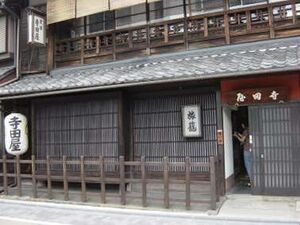The Teradaya (Terada Inn) is located in the port town of Fushimi, south of Kyoto. Situated next to the Satsuma residence in Fushimi, the Teradaya was a known gathering place for ronin loyal to the pro-imperial cause and was the scene of two of the most spectacular events in the Bakumatsu era.
Founded six generations earlier by a farmer from Terada Village by the name of Isuke, in the 1860s, the inn was being run by Isuke VI, and his wife Otose.[1]
Teradaya Incident
- 1862/4/23 (May 21st, 1862)
Approximately 60 to 70 pro-imperial loyalists met at the Teradaya to plot a revolt in Kyoto aimed at seizing control of the Imperial palace. Nearly 50 of these ronin conspirators hailed from Satsuma. When Shimazu Hisamitsu, de facto daimyo of Satsuma and a supporter of "Kobu Gattai" (union of court and camp), caught wind of the plot, he was outraged and ordered that they be brought back to Satsuma’s residence in Kyoto and to eliminate them if they refused.. Hisamitsu’s actions were in accordance with the edict he received from Emperor Komei ordering him to suppress Kyoto’s ronin problem.
As it was highly unlikely that any of these Satsuma shishi would back down and surrender peacefully without a fight, blood would have to be spilled. To that end, nine Satsuma samurai were dispatched to bring their wayward brothers back to Kyoto-- or to bring the swords of justice down upon their unsuspecting fellow clansmen. After a brief and bloody clash that left numerous rebels and at least one Satsuma swordsman dead, an emotional appeal was issued to the remaining Satsuma rebels to obey Hisamitsu’s orders and return to the Satsuma residence in Kyoto. Shocked at the Satsuma-on-Satsuma blood letting and influenced by the strength of the emotional appeal to surrender, the remaining Satsuma shishi yielded. Thus, the first planned armed anti-Bakufu plot came to naught before it could be hatched.
Sakamoto Ryoma’s Near Brush with Death
- 1866/1/23 (March 8, 1866)
After helping to broker the military alliance between Choshu and Satsuma that would eventually topple the Tokugawa Bakufu, Sakamoto Ryoma stayed at the Teradaya with a friend from Choshu, Miyoshi Shinzo. Although he was trying to keep a low profile, it became known to Fushimi’s Bakufu bugyo (government commissioner) that a big-named member of the pro-loyalist movement was staying at the Teradaya.
Even though it was not known that the actual "big name" was Sakamoto Ryoma, the Fushimi bugyo ordered 20 heavily armed Bakufu patrolmen to apprehend the "big fish". Luckily for Ryoma, he wasn’t taken off guard. Using his Smith & Wesson revolver, Ryoma and Shinzo battled their way out of the deathtrap and to safety. During the melee, which also included hand-to-hand exchanges that forced Ryoma to use the revolver to parry slashing attacks from short swords, Ryoma sustained light wounds to his hands. After downing some of the Bakufu samurai with rounds from his pistol, the patrolmen pulled back in order to re-group. Unable to handle his weapon any longer due to his wounds, Ryoma and Shinzo took advantage of the lull in the fighting to make their escape to freedom through the unguarded back stairs.
Ryoma’s actions on that night at the Teradaya have become forever immortalized in both print and film. Today, visitors to the reconstructed Teradaya can see reconstructions of the room in which Ryoma and Shinzo made their desperate stand, along with a collection of Ryoma-related artifacts. The rooms and reconstructed building overall are presented as though they remain largely unchanged since that fateful night. Numerous sword scars and a bullet hole have been recreated as testament to the fury of the fighting.
References
- Hillsborough, Romulus. RYOMA- Life of a Renaissance Samurai. Ridgeback Press, 1999
- Jansen, Marius B. Sakamoto Ryoma and the Meiji Restoration. Columbia University Press, 1994.
- Shiba, Ryotaro. Drunk as a Lord. Kodansha International, 2001.
- ↑ Pamphlet obtained on site.
